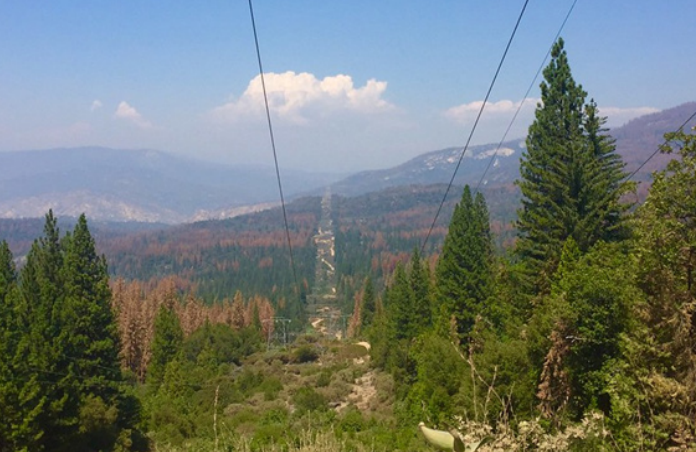Vegetation Clearing and Brushing
Risk Reduction Category
Technology Description
Preventing wildfire intrusion into a utility right of way (ROW) involves removing brush and trees from the area. Typically, this involves the physical removal of vegetation and/or applying herbicide to inhibit future growth—environmental compliance may become an issue. While such actions may have been be ad hoc in the past, the increasing likelihood of wildfires due to drought conditions in many areas not previously experiencing such dry conditions may require a more active and systematic approach to ROW vegetation removal. Therefore, a methodical plan specifying which areas are to be cleared along with the methods to be used should be in place. Should clearing as needed prove more economical than clearing on a set schedule, the plan should include regular surveillance of all ROW areas to assess that need. Over time, trees and brush may grow significantly as may be seen in the figure below.

These activities should include brush clearing around poles having an electrified asset or expulsion fuse (10- foot radius suggested). Otherwise, regular pole spans may be skipped. Trees within the ROW should be removed and clearance distances should be maintained to prevent contact with tree lines. Overhanging limbs should be pruned, and tall trees outside of the transmission ROW that may fall or blow into the ROW should be removed. Weed abatement may also be necessary. The removal of pruned/trimmed/mowed vegetation thus cleared should be considered as leaving the debris on the ground can pose a fire hazard in the event of a wildfire—especially in High Fire Risk Areas (HFRA). Forested areas may allow coordination with US Forest Service maintenance activities where applicable. Depending on the location and availability of sufficient numbers of herbivores, grazing may become an option for clearing brush in the ROW. Permits and environmental impact studies may be necessary at certain locations prior to any brush-clearing activity.[1] San Diego Gas and Electric (SDGE) has used goats in this way as well.[2]
Tools and machinery may be used for pruning, trimming, and tree removal. Clearing of understory growth (grass, brush, and small trees—a chipper or shredder may be necessary) in a forested area may prevent flames from reaching the crowns of tall trees.[1]
In the future, satellite imagery may be used to examine poles and surrounding areas to determine whether or not mowing is necessary. Also, sprays may be available to prevent growth in the ROW for up to two growth seasons
Technical Readiness (Commercial Availability)
The following list of manufacturers is the product of an Internet search using a general description of the technology as the search term. Sometimes more than one variation on the search term is used. The objective is to identify the most demonstration-ready products available in the category. Toward assessing demonstration readiness, the manufacturer websites typically provide useful information such as writeups of successful use cases or field demonstrations, number of deployments, or other indicators. Where lack of information exists online, further inquiry is made by phone. Generally, one to three frontrunners emerge as being most ready for a field demonstration. Preference is given to manufacturers who sell to the United States, or, if emerging technology, those who have participated in US-based field demonstrations.
Large mulching machines are available including various attachments for specific uses (mulching, stump removal, etc.):
https://fecon.com/clearing-right-of-way-land-requires-the-right-equipment/
Various contractors perform vegetation clearing activities. Two examples are provided for reference:
https://lanracorp.com/right-of-way-clearing2/
https://www.steintree.com/why-is-right-of-way-clearing-important/
Implementations / Deployments
Southern California Edison (SCE) is in the process of developing a Fuel Removal Assessment Plan for Wildfire Management to aid with their wildfire mitigation efforts.[1]
Allowing goats to graze on non-native shrubs in ROW may work in small, contained areas; however, goats will also consume native plant species, possibly interfering with restoration projects. [3]
Innovations as of Mid 2023
From Perimeter Solutions: ground-based, or ground-applied fire retardants for wildfire prevention in high risk areas: PHOS-CHEK Fortify and PHOS-CHEK LC-95W. These may be found on the USDA Forest Service Qualified Products List (QPL). [3]
References
[1] SCE Fuel Removal Assessment for Wildfire Mitigation. EPRI, Palo Alto, CA: 2022. 3002023370.
[2] 2022, No.1 Winter edition and the EPRI Journal 1988 No.2
[3] Electric Transmission Right-of-Way Invasive Non-Native Woody Plant Species Control. EPRI, Palo Alto, CA:2006. 1010127.